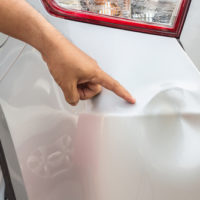Car Accidents Causing Minimal Visible Damage to Cars Can Still Harm Occupants

When you’re in an accident that does little damage to the outside of your car, you might be surprised to find yourself wincing in pain when you wake up the following morning. While common wisdom says that an accident’s potential to cause injuries can be assessed by looking at the amount of damage done to the car itself in the crash, modern car design and advances in research on the effects of a crash on vehicle occupants have proven this notion to be incorrect. Read on to learn about the ways that even a crash causing minor damage can lead to injuries, and the difficulties involved in succeeding with a claim for expenses related to your injuries.
Many car insurance carriers have a practice of denying claims for injured passengers made in crashes that cost less than $1,000 in repairs to the car in which they were traveling. After all, how could someone be truly hurt if the car suffered only minor damage? These insurers hire biomechanical experts who testify at trial to the fact that injuries simply don’t occur in low-damage crashes, making it difficult for claimants to recover for their medical bills.
Not only is it insulting to be called a fraud by an insurance company, this sort of expert testimony simply doesn’t reflect the current state of research into the effects of an accident on the body. Recent studies have shown that the phenomenon of cervical acceleration-deceleration (CAD) trauma can occur in collisions at speeds as low as 25 mph. CAD trauma is the result of the body being flung forward from a rear impact and abruptly stopped by either a seat belt or steering wheel, then flung back against the seat. This causes damage to muscles, ligaments, and tendons, and can force the spine out of its natural S-curve when forced back against the seat. High speeds are not necessary to produce this sort of injury.
Even when crashes do occur at higher speeds, modern cars often don’t show the same amount of damage that past cars might have shown. As car design has advanced, cars are increasingly engineered toward preventing superficial damage to the outside of the vehicle, which can result in a transfer of the force of impact that was not absorbed by the car, to the passengers. In fact, the National Highway Transportation Safety Administration states that bumpers are not intended to protect occupants from injury, but rather are intended to prevent damage to vehicles. Thus, an unscathed car may still have held injured passengers.
If you’ve been hurt in a low-damage crash in Southern California and need help fighting for your right to compensation from your insurer for your injuries in the accident, contact the knowledgeable and determined personal injury attorneys at Magaña, Cathcart & McCarthy for a consultation on your case, at 310-553-6630.


 Close Menu
Close Menu